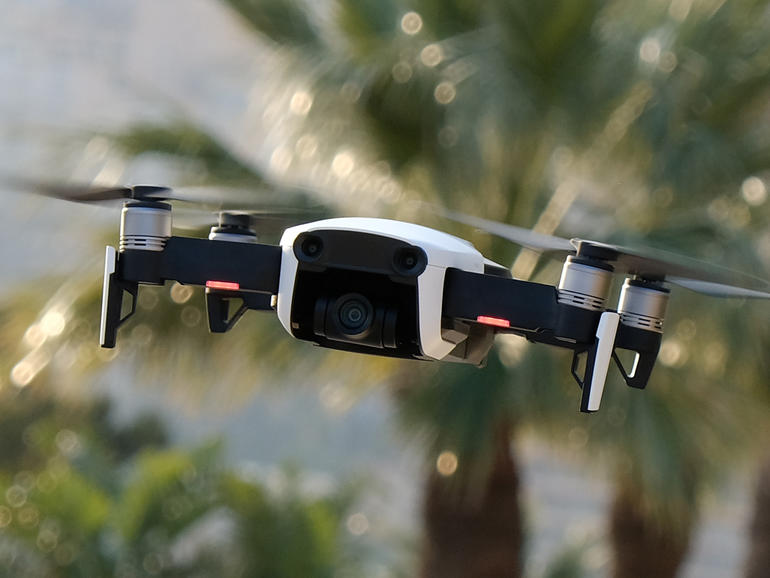DJI Mavic Air review – in pictures
Clear a space in your backpack for DJI's best drone yet...

DJI Mavic Air review – in pictures
Take the best tech from the 4K-shooting Mavic Pro and the best software features of the more beginner-friendly Spark. What do you have? The DJI Mavic Air. Its magic mix makes for an approachable drone that can shoot epic travel videos, even if you have less-than-epic piloting skills. And also one that, with a flick of the controller’s Sport button, can zoom around an RC playing field at over 40mph in Sport mode. It isn’t absolutely flawless (and still suffers from the same practical restrictions as other drones) – but it is the best all-round drone hobbyists can buy…

DESIGN: MICRO MACHINE
As you can see, the Mavic Air has almost pocketable dimensions when folded up, and slips into a backpack faster than us dashing into a pub during a downpour. At 430g, it weighs less than a pint too. It might look like a toy (particularly in its Flame Red paint job), but the Air is incredibly well built and has a few subtle improvements over the Mavic Pro that make it much more travel-friendly.

DESIGN: BETTER BUILD
Its 4K camera is now much better protected and comes with a clip-on plastic guard. The controller’s joysticks unscrew to make it easier to slip into a backpack. Its hot-swappable battery mechanism is more decisive and secure. And dampeners on the three-axis mechanical gimbal (a crucial improvement over the Spark’s two-axis affair) create video that’s so buttery smooth it should come with a cholesterol warning.

FEATURES: AUTO APPEAL
The Mavic Air’s killer combination is shooting 4K video from a three-axis gimbal, which is something we just haven’t seen from a drone of this size. Like the Spark, the Mavic Air also packs a ton of autonomous skills that are the equivalent of your camera’s ‘auto’ mode. There are two new Quickshots, which are short, one-button cinematic sequences.

FEATURES: LONG-RANGE SHOOTING
Looking to shoot longer videos or fly it further? While the Air’s max range using Wi-Fi from your smartphone is 80m away (or 50m high), the range stretches to 4km if you use the bundled controller. Although, according to UK laws, you technically still need to keep it in your line of sight.

THE CONTROLLER: CRUCIAL SIDEKICK
Adding this to the Spark would cost you an extra £130 and, unless you plan on solely relying on autopilot Quickshots, it’s crucial for flying your drone properly and boosting its range beyond 80m. The sticks give you far greater control than a touchscreen and there are lots of handy physical buttons that ensure you don’t need to squint at your screen. Shoulder buttons start video or take a snap, there’s an emergency ‘home’ button on the top left should you panic, and Sport mode in the centre unlocks its 42.5mph top speed.

PERFORMANCE: SMOOTH OPERATOR
Unless you’re a pro videographer, the Mavic Air offers the best video and stills performance of any drone you can buy right now. It’s particularly at home in brighter conditions, where its 1.2/3in sensor really picks sharpness and detail that matches the Mavic Pro (and thanks to its higher 100Mbps bitrate, perhaps even surpasses it). The 3-axis gimbal keeps things incredibly smooth too, even in windy conditions.

THE DOWNSIDES: NOT QUITE AS FREE AS A BIRD
While its 21-minute battery life is an improvement on the 16-minute Spark, in reality you’ll more realistically get about 15 minutes in the air after connecting, taking off and landing. Then there’s the noise factor: unlike the Mavic Pro Platinum, there’s no option of low-noise propellers. While the Mavic Air can only be faintly heard when up in the sky, it does basically sound like a lawnmower when taking off or landing.

DJI MAVIC AIR VERDICT
DJI’s Mavic Air is such a good all-rounder that it’s actually hard to recommend getting either the DJI Spark or the Mavic Pro ahead of it, unless price or battery life considerations put you off. It’s our current favourite flying, autonomous 4K camera – an amazing gadget that slips into a hiking backpack and can shoot videos that would have, until recently, required serious flying skills and a film studio budget.


